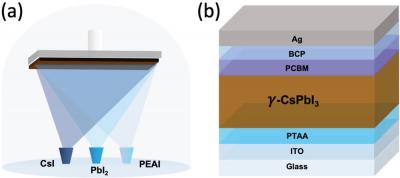Researchers at the Dresden University of Technology (TUD) have announced the fabrication of a solar cell based on all-inorganic cesium-lead iodide (CsPbI3) perovskite, which is also sometimes referred to as 'black perovskite'.
 a) Schematic of the deposition procedure (b) device structure. Image from Advanced Energy Materials
a) Schematic of the deposition procedure (b) device structure. Image from Advanced Energy Materials
TUD researcher Yana Vaynzof said that the choice of this specific material was motivated by the fact that it shows superior stability as compared to the commonly used organic-inorganic lead halide perovskites.
Lead(II) iodide (PbI2) and cesium iodide (CsI) were co-evaporated at a low temperature of 100 degrees Celsius with a small amount of phenylethylammonium iodide (PEAI), which is an ammonium salt used to improve stability and optoelectronic quality in perovskite cells. 'The PEAI containing thermally evaporated γ-CsPbI3 perovskite films exhibit a far better film microstructure and a preferential crystal orientation,' the scientists explained, noting that this results in a substantial decrease in defect density.
The solar cell showed a power conversion efficiency of 15% and an open-circuit voltage of 1.1 V. 'Moreover, this performance surpasses that reported for solution-processed PEAI containing γ-CsPbI3 perovskite solar cells (PSCs) based on the same composition, illustrating that thermally evaporated PSCs can compete and even outperform most PSCs deposited from solution,' the researchers said.
The cell was also able to retain around 90% of its initial performance after 215 days of exposure to dim light at room temperature. 'The development of efficient and stable thermally evaporated solar cells is of key importance to their future integration into industrial applications,' Vaynzof emphasized. 'Due to the low temperature of processing (

